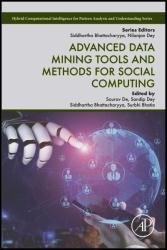 Название: Advanced Data Mining Tools and Methods for Social Computing
Название: Advanced Data Mining Tools and Methods for Social ComputingАвтор: Sourav De, Sandip Dey
Издательство: Academic Press, Elsevier
Год: 2022
Страниц: 292
Язык: английский
Формат: pdf, epub
Размер: 10.2 MB
Advanced Data Mining Tools and Methods for Social Computing explores advances in the latest data mining tools, methods, algorithms and the architectures being developed specifically for social computing and social network analysis. The book reviews major emerging trends in technology that are supporting current advancements in social networks, including data mining techniques and tools. It also aims to highlight the advancement of conventional approaches in the field of social networking. Chapter coverage includes reviews of novel techniques and state-of-the-art advances in the area of data mining, Machine Learning, soft computing techniques, and their applications in the field of social network analysis.
Social networks have received increased attention since the 2010s, and they turned into an extraordinary region of Computer Science that involves a combination of social behavior and computational systems. Different kinds of social networks have been developed, like Google+, Facebook, Twitter, scientific cooperation networks, and airport networks. Social networks deal with huge volumes of heterogeneous and unstructured data that are very tough to handle. Due to the increasing volume and popularity, social network data analysis has become one of the most promising and attractive research areas. Data mining techniques aim to obtain information by finding patterns/correlations among data patterns. These data are applied in different applications like business, training, online life, the medical field, agriculture, and so on. Data mining algorithms and tools are efficiently and effectively applied to handle social media data. This book present an overview of different novel and hybrid high-quality data mining methodologies, techniques, algorithms, architectures, tools, and methods to deal with issues related to social network data analysis.
This volume presents major emerging trends in the field of social networks which support the current advancement of social networks with the help of data mining techniques and tools. It also aims to highlight advances in conventional approaches. This volume (i) reviews state-of-the-art techniques in the areas of data mining, Machine Learning, soft computing, etc., and their applications in the field of social networks and (ii) proposes novel techniques. We aim not only to put forward innovative technological ideas, but also to analyze their effects in the current context of social media analysis.
Data Analytics life cycle, basically a defined approach for managing and executing analytical projects, describes the whole process in six phases viz. Data Discovery, Data Preparation, Model Planning, Model Building, Communicating the results and Operationalize the model for real-life data. The life cycle involves collecting, classifying, summarizing, analyzing, organizing and interpreting scientific and non-scientific information for better decision making and conclusion drawing. There are, in general, two types of data used in general data analytics: qualitative (which cannot be measured on a natural numerical scale) and quantitative (which can be measured on a natural numerical scale).
Before Hadoop or similar architectures arrived into the picture, raw data moved through the ETL process stored into a database or data warehouse for further processing through known data models. But now Hadoop-like architectures not only support relational data models, but are also able to handle dynamic formats and data layouts based on their local features or properties. Sometimes the occurrence of certain event grows as the size of the data grows. But those positive responses will not always be significant in selecting crucial features in the large data sets. This characteristic of data is popularly known as “Bonferroni’s principle.”
Over the years, data mining has evolved from basic statistical modeling to knowledge discovery, accommodating different Machine Learning algorithms with some efficient mathematical models for successfully categorizing linear and non-linear relations prevalent among datasets. Data mining activity generally includes descriptive modeling, predictive modeling, exploratory data analysis, pattern discovery, and content retrieval. Initial data mining algorithms were known to be slow and memory inefficient. Such faults were largely not noticed until the recent advancement of large data sets computation, where datasets with millions or billion records or more could the limit. Even if the entire dataset fits into the memory, an additional memory chunk is required for processing and manipulating the data. Presently some open source softwares like R, Python, etc., are available in the market to efficiently deal with such situations. In the present chapter, we have consolidated all popular data mining techniques under a modern Machine Learning framework, viz. H2O.
- Provides insights into the latest research trends in social network analysis
- Covers a broad range of data mining tools and methods for social computing and analysis
- Includes practical examples and case studies across a range of tools and methods
- Features coding examples and supplementary data sets in every chapter
Скачать Advanced Data Mining Tools and Methods for Social Computing